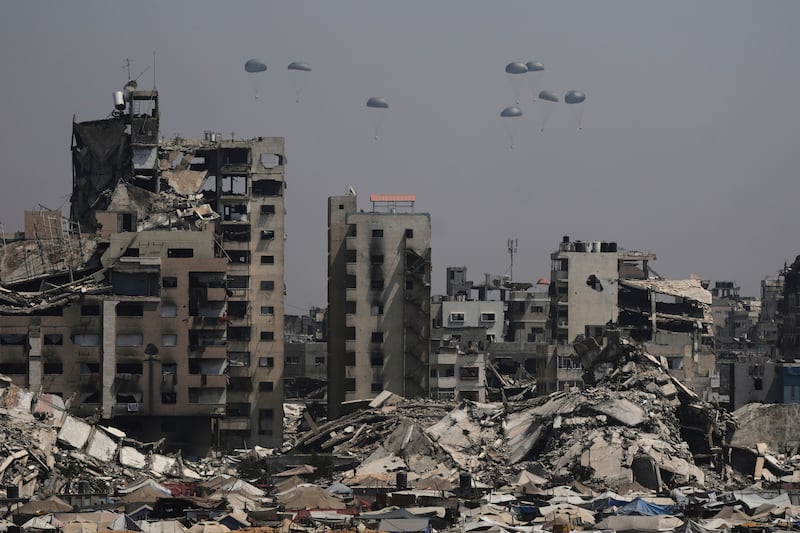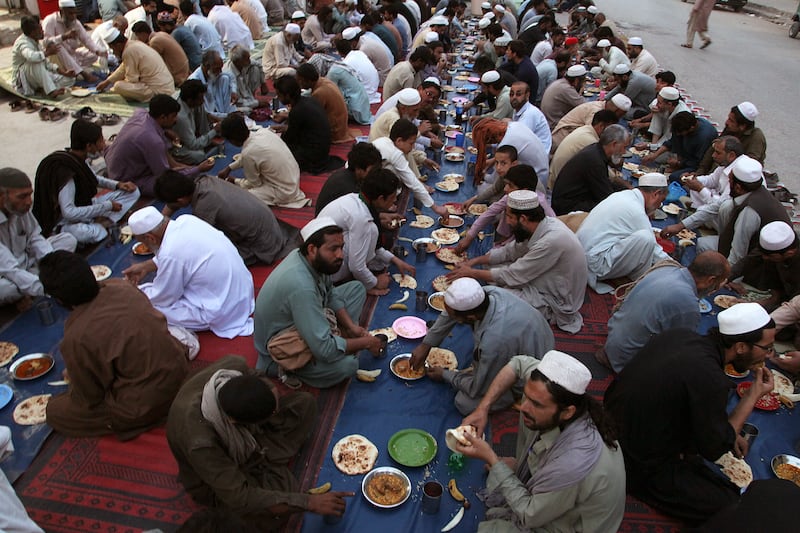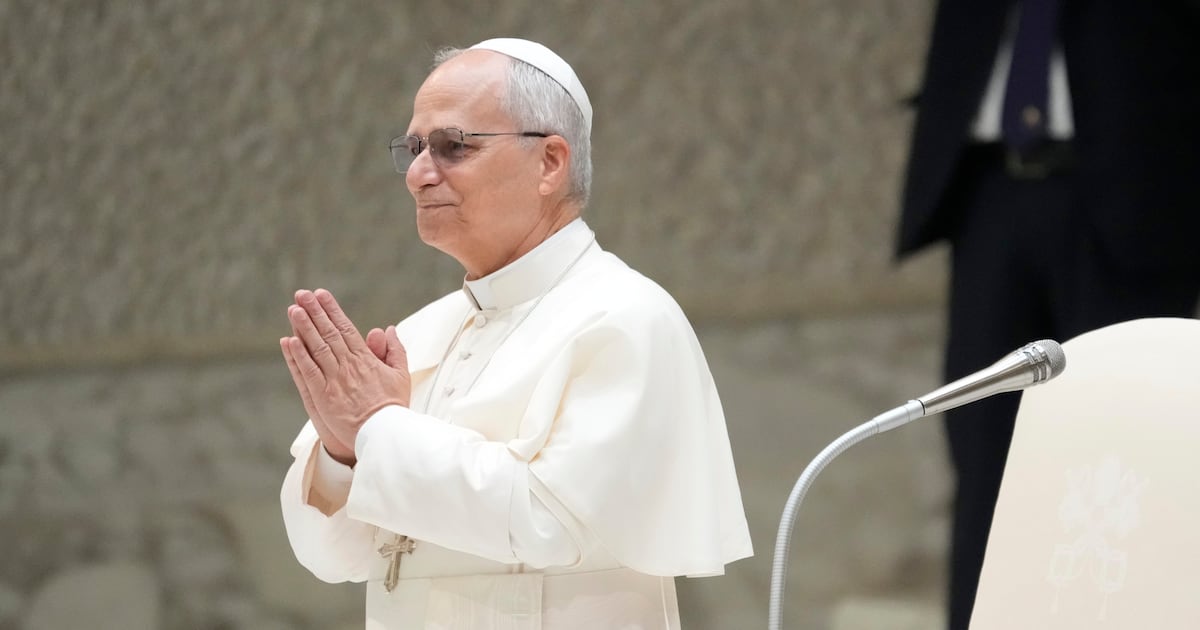When Pope Leo XIV stepped onto the St. Peter’s Basilica balcony to introduce himself to the world, he gave a short speech — about 500 words. But in that speech, he used the word “peace” nine times. Since then, the theme of peace has been central to his papacy, most recently in his call for prayer and fasting.
Addressing the general audience on Wednesday, Pope Leo marked Aug. 22 as a day of prayer and fasting and invited 1.4 billion Catholics in the world, and all believers, to plead for peace and justice so that God would “wipe away the tears of those who suffer because of ongoing armed conflicts.”
The day is celebrated as the feast of the Queenship of Mary, and Pope Leo called Mary “the Mother of the faithful on earth” — honoring her as the “Queen of Peace.”
“While our world continues to be wounded by wars in the Holy Land, in Ukraine and in many other regions of the world,” he said, “I ask all the faithful to spend Aug. 22 in fasting and prayer, asking the Lord to grant us peace and justice and to dry the tears of those who suffer because of the armed conflicts underway.”
Pope Leo, who is the first American to lead the Catholic Church, asked the Polish pilgrims in the audience to pray for the “the gift of peace that is disarmed and disarming — for the whole world, especially for Ukraine and the Middle East.”
 Humanitarian aid is airdropped over Gaza City, Gaza Strip, July 28, 2025. | Jehad Alshrafi, Associated Press
Humanitarian aid is airdropped over Gaza City, Gaza Strip, July 28, 2025. | Jehad Alshrafi, Associated Press “It was very evident that peace was going to be a front-burner issue for his papacy, particularly in the early days,” said Christopher White, a journalist and author of “Pope Leo XIV: Inside the Conclave and the Dawn of a New Papacy.” White is also the Vatican analyst and reporter for NCR, NBC News and MSNBC. “The world at war is what I think is probably keeping him up at night.”
Legacy of ancient practice
Although this is Pope Leo’s first call for a global fast, he has called for peace on numerous occasions. In his first Sunday blessing, he shared a plea for an end to wars across the globe: He declared “Never again war!” — a phrase the popes have repeated since World War II, and called for “authentic, just and lasting peace.” He also called for the release of prisoners and the return of Ukrainian children who were deported by Russia.
Pope Leo’s first call with a foreign leader was to Ukrainian President Volodymyr Zelenskyy in May, where the two talked about ceasefire proposals, the forced removal of Ukrainian children by Russia and efforts to end the war.
While fasting is a common practice for Catholics, particularly around Lent, papal calls for special days of fasting are significant and signal the Pope’s attention to urgent global causes, White said.
In calling for the special fast, Pope Leo is following in the footsteps of his predecessors. Following the 9/11 terrorist attacks, Pope John Paul II invited Christians to a day of fasting, saying he hoped “that the common attitude of religious penance will increase reciprocal understanding between Christians and Muslims.”
Amid escalation of the war in Syria in 2013, Pope Francis called on the Catholics to observe a day of prayer and fasting. Pope Francis also called to observe the practice on the first anniversary of the Hamas-Israel war on Oct. 7, 2024.
“(Pope Leo) is following the path that popes before him have followed using the ancient Catholic practice of fasting,” White said. “And even with all sort of wellness and health trends around intermittent fasting, it’s still a particular and special custom in the life of the Catholic Church to sacrifice, and show solidarity and remembrance of grave injustices and concerns for human dignity.”
Fasting has meaning across many cultures and religious traditions. About 21% of adults observe periods of fasting during holy times, according to a Pew Research Center survey from 2024. The most likely religious group to fast for religious reasons are Muslim Americans, followed by Jewish Americans, Catholics and Black Protestants, according to the survey. Among Catholics, 4 in 10 reported fasting.
 People break their fast during the Muslim holy fasting month of Ramadan at a roadside, in Peshawar, Pakistan, Wednesday, April 6, 2022. Ramadan is marked by daily fasting from dawn to sunset. | Muhammad Sajjad, Associated Press
People break their fast during the Muslim holy fasting month of Ramadan at a roadside, in Peshawar, Pakistan, Wednesday, April 6, 2022. Ramadan is marked by daily fasting from dawn to sunset. | Muhammad Sajjad, Associated Press In 2020, President Russell M. Nelson, the president of The Church of Jesus Christ of Latter-day Saints, invited members to hold a global fast for relief from the effects of the COVID-19 pandemic.
“Fasting has very ancient roots and it’s understandable by everyone, even by those who are not religious or Christian,” Massimo Faggioli, professor at Loyola Institute at the School of Religion, Theology and Peace Studies, told Deseret News in an email. “Fasting is also a way of signaling solidarity with those who are suffering hunger because of war.”
The opposite of grandstanding
Pope Leo’s peace messages stand out because today’s major conflict centers on Israel, which includes the war in Gaza but also assaults by extremist Israeli settlers on Christian communities in the West Bank, Faggioli says.
“This is very sensitive for Catholics as a religious community and for the Vatican and the Holy See as an actor on the international stage because of the role of the Church in the history of antisemitism,” Faggioli said over email. “Fasting is an interesting choice because it’s a symbolic, quiet way to make a statement. Fasting is also a form of penance and it’s the opposite of grandstanding.”
The Vatican’s religious response to global crises also reflects the shortcomings of diplomatic efforts and international organizations, Faggioli noted. “It’s a failure that calls religions and the Vatican especially to do something in substitution,” he said.
While it’s a symbolic act, Pope Leo’s focus for peace is meant to have a practical effect, too, White said. “The Pope has one of the largest megaphones in the world and he’s trying to use that as often as he can to reiterate the call for peace.” For instance, this week, the Catholic Bishops have announced a special collection for “humanitarian relief and pastoral support in Gaza.”
Pope Leo has also offered the Vatican as a space for peace talks — just before the funeral of Pope Francis, President Donald Trump and President Zelenskyy met inside St. Peter’s Basilica to discuss the war in Ukraine. The Vatican has also offered to use its global network to help with bringing back Ukrainian children who were forcibly taken by Russia, White said. “The Vatican (is) doing what it can from a very practical boots on the ground perspective,” he said.
